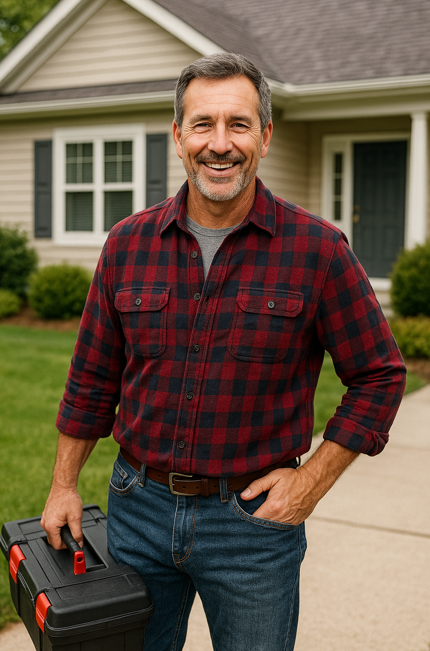Is a 20 kW Electric Furnace Enough? Let’s Break It Down Room by Room
If you’ve landed here, chances are you’re eyeballing this Goodman 68,240 BTU 20 kW Electric Furnace and wondering: is this thing enough to heat my whole home? Well, you’re not alone—and I’ve been there. My name’s Mike, and I’m just your average middle-class homeowner who’s had to learn this HVAC stuff the hard way (wallet-first).
So let’s get into it. I’m going to walk you through whether a 20 kW electric furnace can do the job for your home—room by room, square foot by square foot.
Quick Refresher: What Does 20 kW Mean in Furnace Terms?
20 kilowatts sounds big, but let’s put that in more relatable terms. One kilowatt equals about 3,412 BTUs. So, 20 kW x 3,412 = 68,240 BTUs of heating power.
That’s your baseline.
According to the U.S Department of Energy, you need about 30–60 BTUs per square foot of living space, depending on where you live, how well your house is insulated, and how many drafts your kids leave open every day.
So for example:
-
In Texas or Florida: 30–35 BTUs/sq ft
-
In the Midwest: 40–50 BTUs/sq ft
-
In the Northeast: 50–60 BTUs/sq ft
Let’s work through that with some real-world numbers.
Room-by-Room Furnace Needs
Let’s say you’ve got a standard 2,000 sq ft home in a place like Indiana. Decent insulation, maybe built in the 1990s. Here’s a rough breakdown:
Living Room – 400 sq ft
-
Midwest average: ~45 BTUs/sq ft
-
Total: 18,000 BTUs
Kitchen + Dining – 300 sq ft
-
These areas give off heat when you cook, so maybe dial it down to ~40 BTUs/sq ft
-
Total: 12,000 BTUs
Bedrooms (3 total, 150 sq ft each) – 450 sq ft
-
45 BTUs/sq ft
-
Total: 20,250 BTUs
Bathrooms (2 total) – 100 sq ft
-
Small, but need quick heat. Use 50 BTUs/sq ft
-
Total: 5,000 BTUs
Hallways, Entry, Utility – 250 sq ft
-
Use a blended average: 40 BTUs/sq ft
-
Total: 10,000 BTUs
Total: 65,250 BTUs
Boom—you’re just under 68,240 BTUs. So yes, a 20 kW electric furnace is just about right for a well-insulated 2,000 sq ft home in a colder region.
Now, if your home’s a little bigger, or your insulation isn’t great, you might want to size up or tighten that envelope.
Don’t Forget About CFM: The Airflow Factor
This particular Goodman model delivers 2,000 CFM (Cubic Feet per Minute) of airflow. That’s plenty to keep warm air moving through most standard ductwork systems. Just make sure your ducts aren’t all pinched or leaky, or you’ll lose performance.
Bonus: What About Operating Cost?
This one’s electric, and some folks shy away from electric heating because they think it’ll cost more. But let’s be honest: the math’s not always that bad.
If electricity costs $0.13 per kWh and you’re running the furnace 5 hours a day:
-
20 kW x 5 hrs = 100 kWh/day
-
100 kWh x $0.13 = $13/day
-
Over 30 days = $390/month (rough average during peak winter months)
Gas might be cheaper per unit, but if you don’t have gas lines or want to avoid combustion appliances, electric makes a lot of sense—especially in newer builds or mobile homes.
Want a side-by-side breakdown? Check out EnergySage’s cost comparison of electric vs. gas furnaces.
When a 20 kW Furnace Might NOT Be Enough
Just to be straight with you, here are a few cases where I’d think twice:
-
You live in the far North or mountains: You might need more than 70,000 BTUs.
-
You’ve got high ceilings everywhere: More cubic volume = more heat needed.
-
Your home leaks air like a screen door: Get an energy audit. Seriously.
-
You want future add-ons: Planning to finish your basement next year? Account for it now.
If any of those apply, check out a bigger unit—or even consider pairing with a mini-split system to boost specific zones.
Final Thoughts from Mike
Look, heating your home shouldn’t feel like decoding rocket science. I like this Goodman 20 kW model because it hits that sweet spot—enough heat for most homes, good airflow, and a reliable brand.
Plus, when you buy through The Furnace Outlet, you can be sure you’re not overpaying for a big-box name or middleman markup.
Want to know how to install it yourself? I’ve got a DIY guide coming soon.
In the meantime, give your square footage a hard look, check that insulation, and remember: sizing your furnace right the first time will save you a lot more than just heat—it saves hassle.
Got questions? Shoot me a message. I'm Mike—just a homeowner like you, trying to stay warm without going broke.







